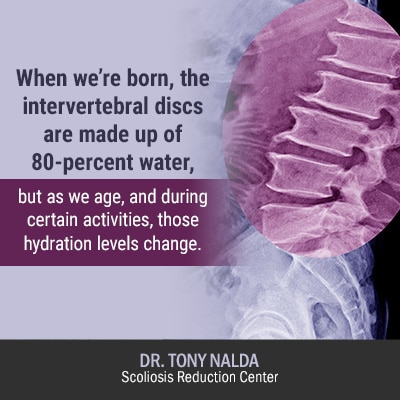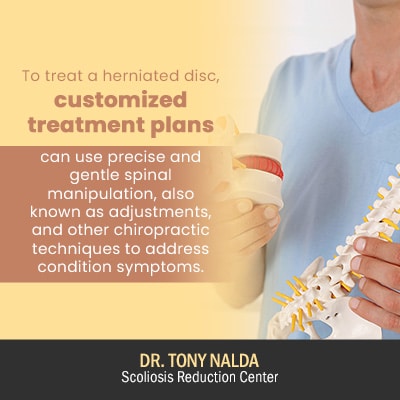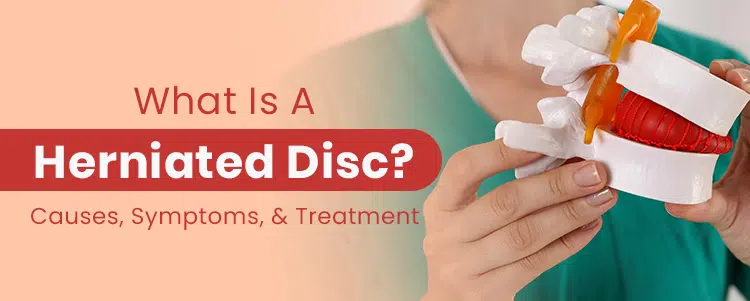When we’re born, the intervertebral The overall health and function of the spine are dependent upon the health of its individual parts, such as its intervertebral discs. As the discs provide the spine with cushioning, flexibility, structure, and facilitate its absorption/distribution of mechanical stress if a disc starts to deteriorate and becomes herniated, it can produce a wide range of symptoms and impact the spine in different ways; keep reading to find out how.
Spinal discs have two main parts: an inner gel-like nucleus and a durable outer casing called the annulus. When a disc becomes herniated, part of the inner nucleus pushes through a tear in the annulus; this is most often caused by age-related degenerative changes and can cause a variety of symptoms.
Let’s start our discussion on disc herniation by exploring some basic spinal anatomy and the important roles intervertebral discs play in maintaining optimal spinal health and function.
Spinal Anatomy
The spine is important for many reasons; it allows us to stand upright, practice good posture, protect vital organs, and work with the brain to form the body’s central nervous system (CNS).
The body’s CNS allows sending signals between the brain and the rest of the body, so spinal health is important for the optimal function of many bodily systems and parts.
The spine has three main sections: cervical (neck), thoracic (upper/middle back), and lumbar (lower back). Each spinal section has a characteristic curvature type, which is why a healthy spine has a soft ‘S’ shape when viewed from the sides and appears straight when viewed from the front and back.
The spine’s natural and healthy curves give it added strength and flexibility and facilitate its absorption and distribution of mechanical stress.
Suppose the spine loses one or more of its natural curvatures. In that case, the spine’s overall biomechanics are disrupted, and the spine’s intervertebral discs are important for maintaining those natural and healthy spinal curves.
So let’s talk about the structure and roles of the spine’s intervertebral discs.
Intervertebral Discs
In a healthy spine, the vertebrae (bones of the spine) are stacked on top of one another in a straight and neutral alignment, and the spine’s intervertebral discs separate the vertebrae.
As mentioned, the discs themselves consist of two main components: a soft gel-like interior (nucleus pulposus) and a tough, durable outer layer (annulus fibrosus). The inner nucleus houses a hydrated gel-like material that resists compression and is made up of water, collagen, and proteoglycans (molecules that attract/retain water).
The outer annulus is a tough structure made up of concentric layers of lamellae (collagen fibers); the layers have various angles that connect to the vertebral end plates. Collagen is known as the glue that holds structures of the body together and gives them structure.
While both structures consist of the same components (water, collagen, proteoglycans), fluid levels are greatest in the inner nucleus.
For the discs to perform optimally, they need to be well hydrated, which can be a challenge as the intervertebral discs are the largest structures within the body that don’t have their own vascular supply; this means there is no direct path into and out of the discs for transporting blood (nutrients), oxygen, and eliminating waste.
Instead, the discs rely on a process similar to osmosis for absorbing nutrients from the end plates that hold the discs in place.

When we’re born, the intervertebral discs are made up of 80-percent water, but as we age, and during certain activities, those hydration levels change.
If a disc starts to lose fluid, a process called desiccation, it can lose height, and this can affect the position of the vertebrae that attach to each of the discs’ end plates.
Injuries and trauma can also affect the discs and how they function.
So the discs of the spine are fibrocartilaginous cushions that act as shock absorbers that help protect the vertebrae, brain, vital organs, and a variety of structures like nerves.
While individual disc movement is limited, a considered range of spinal motion is facilitated when multiple discs combine forces.
So now that we understand some basic spinal anatomy and the structure and function of the intervertebral discs, what does it mean when a disc becomes herniated?
What is Herniated Disc?
As mentioned, the inner nucleus is encased by the tough outer annulus. When a disc herniates, this means some of the inner nucleus has pushed its way through a tear in the annulus, and this can happen for different reasons.
Also called a slipped or ruptured disc, a herniated disc can happen anywhere in the spine, which can irritate surrounding nerves.
Disc herniation occurs in stages, starting with a healthy and hydrated disc which, as it starts to degenerate, can change the shape of the nucleus within and the thickness of the outer annulus.
Prolapse occurs as the nucleus starts to push against the inner edge of the annulus (tough outer casing), leading to extrusion: when the nucleus pushes its way to the outer edge of the annulus. The final stage of sequestration occurs when the nucleus pushes through the annulus, intruding into the vertebral space.
Depending on the location of the herniated disc and the degree of spinal-nerve involvement, it can cause a wide range of symptoms. It is also possible for people with herniated discs not to experience any related symptoms.
Herniated Disc Symptoms
While herniated discs most commonly occur in the lumbar spine (lower back), they can also affect the cervical spine (neck), and less commonly, the thoracic (middle/upper) section.
Common signs and symptoms of a herniated disc will vary based on the cause, location, and whether or not the protruding nucleus compresses nearby nerves.
Most often, symptoms affect one side of the body and can include:
Arm and/or Leg Pain
If the herniated disc is located in the lower back, common symptoms include pain in the buttocks, thigh, calf, and pain on the foot.
If the herniated disc is located in the neck, common symptoms include pain in the shoulder and arm that can radiate into an arm or leg, particularly during coughing, sneezing, and when changing certain positions.
Herniated disc-related pain is commonly described as sharp and/or burning.
In addition to localized pain, feelings of additional discomfort related to radicular pain are also common.
Numbness and/or Tingling
People living with a herniated disc often suffer from radiating numbness and/or tingling in the area related to compressed nerves.
This can be experienced as a loss of feeling in an affected area, or a feeling of pins and needles.
Muscle Weakness
Muscles that surround affected nerves tend to become weaker, partially due to the nerves becoming less functional overall, and also because if nerves are impaired, their ability to send/receive signals from the brain can be disrupted.
In addition, when nerves are compressed and/or damaged, circulation in the area can be affected, meaning muscles located closely to a compressed nerve, or nerve path, can be deprived of oxygen and nutrients.
While not everyone experiences pain related to disc herniation, for those that do, it can be tempting to become less active and mobile, and that related lifestyle change can also lead to muscle weakness.
It is also entirely possible for people with a herniated disc to be unaware of the condition. It’s not uncommon for people to learn of disc issues while getting scanned for other reasons, particularly if they are asymptomatic.
So for those recently diagnosed with a herniated disc, a common question is what caused it.
What Causes a Herniated Disc?
Most often, a herniated disc develops due to natural and gradual age-related disc degeneration.
As a person ages, the discs of the spine become less hydrated and flexible, making them vulnerable to tearing or rupturing, which can happen, particularly with twisting movements or any that strain the back.
It’s also important to understand that disc herniation isn’t a guaranteed aspect of aging. Certain lifestyle-related choices can impact whether or not a person experiences significant spinal degeneration and related disc issues as they age.
For example, if a person is carrying excess weight, this can make the spine, in general, more vulnerable to strain and injury due to added pressure on the spine to support the weight; in particular, the discs of the lower spine feel the effects of carrying excess weight, which is part of the reason disc herniation most commonly occurs in the lumbar spine.
People who have sedentary lifestyles are also more likely to experience spinal degeneration and disc herniation; this is because, as discussed, the intervertebral discs lack their own vascular supply, and it’s through movement that the discs can replenish themselves through increased circulation, increasing the blood supply to the discs’ surroundings.
The very design of the spine is about movement, so a spine that is not experiencing regular movement can develop a number of conditions and issues, in addition to becoming stiff and more vulnerable to injury.
People whose occupation involves repeatedly lifting heavy are also at risk for a number of spinal conditions and injuries if proper precautions aren’t followed.
Repetitive lifting, pushing, pulling, bending sideways, and/or twisting are hard on the spine and its surrounding muscles, and if objects aren’t lifted correctly, with the leg muscles, rather than the back, exposes the spine to excessive strain and uneven wear and tear that, over time, can cause disc herniation.
Less commonly, a trauma such as a blow or a fall can lead to a herniated disc, but in the majority of cases, age-related spinal degeneration and lifestyle-related risk factors are causative sources.
So what are some additional risk factors that can lead to a herniated disc?
Disc Herniation Risk Factors
In addition to the risks mentioned earlier, factors of age-related degenerative changes, obesity, a sedentary lifestyle, and straining the spine, other factors such as genetics and smoking are also thought to play a role.
With genetics, some people inherit a predisposition to disc herniation, and it’s thought that smoking can also increase disc-herniation likelihood because it reduces the oxygen/nutrient supply to the discs, making them more prone to deterioration and herniation.
So now that we have explored the role of the spine, its discs, and explained what disc herniation is, including symptoms and causation, let’s move on to address what can be done in terms of treatment.
How Do You Fix a Herniated Disc?
There are different options for treatment for herniated discs, and here at the Scoliosis Reduction Center®, I believe in a proactive and integrative approach that combines multiple treatment disciplines for the best results.
Crafting treatment plans that are fully customized to the patient are more effective because the more specific treatment is, the more specific results can be achieved.
While there are never treatment guarantees, when it comes to a variety of spinal conditions, particularly those related to spinal degeneration, being proactive with treatment is key.
Early detection doesn’t guarantee treatment results, but it most certainly increases the chances of reaching a positive prognosis as applying treatment before more degeneration and progression has occurred is ideal.
So, what are the treatment options for disc herniation? One of the most common forms of general treatment is prescription medications and injections.
Prescription medications include anti-inflammatory agents that can help strengthen the affected area and combat swelling and inflammation, not to mention pain medications to ease discomfort.
In addition, steroid injections can also be effective if less-invasive medications have failed to show signs of improvement; they can be injected directly into the area surrounding the affected spinal nerves and can be even more specific when guided by ultrasound.
When I’m treating a patient with a herniated disc, I conduct a comprehensive physical exam, combined with taking the patient’s medical history (including genetics), lifestyle factors, orthopedic and neurological testing, and MRI imaging.
Through the information gleaned, I can craft a treatment plan that is 100-percent customized to address important patient/condition characteristics. For example, if I observe or learn of lifestyle choices that increase disc degeneration, I provide guidance on more positive choices that can greatly impact the health of the spine and its intervertebral discs.
Here at the Center, I attempt less-invasive and more natural forms of treatment before turning to medications and injections, but different treatment methods do have their place.
Both exercise and physical therapy, when custom-prescribed and condition-specific, can help with the recovery from a herniated disc and related pain and symptoms.
In fact, while many patients suffering from herniated-disc related pain are inclined to rest and decrease exercise, this is not the best way to respond as lack of movement is a contributing factor to herniated discs and can worsen its effects.
Additional modalities such as heat, massage, electric stimulation, and stretching can also be effective pain-management tools.
As a scoliosis chiropractor, I have a vast amount of experience treating a variety of spinal conditions and issues, disc herniation included, and chiropractic care uses precise and gentle low-force techniques to treat herniated discs.
So let’s talk about some of the ways that chiropractic care addresses herniated discs.
Chiropractic Care and Disc Herniation
As mentioned, my initial examination of a patient with a suspected herniated disc can include combining a physical exam, taking the patient’s history, performing orthopedic and neurological testing, and MRI and/or X-ray imaging.
The physical exam would include a comprehensive assessment of balance, posture, and gait as I can tell a lot about a patient’s condition by their posture and how they walk.
Through the diagnostic and assessment process, I’m looking for answers to the following questions: How are the patient’s reflexes? Is there sensation loss along a nerve path? Are there signs of muscle weakness and/or muscle wasting?
The answers to these questions are important because they tell me whether or not a patient’s nerves are sending messages properly, if the degree of nerve involvement is affecting surrounding muscles, and if affected muscles are limited to those located close to the affected nerve, or muscles that span a nerve route.
I don’t solely examine and treat the section of the spine with the herniated disc as I want treatment to include the entire spine to work towards improving its overall biomechanics, and remember, problems in one section of the spine can cause a myriad of effects felt not just throughout the spine, but also throughout the body.
After determining whether age-related degeneration or an intervertebral disc injury is to blame, and if so, which type, I can craft an effective and customized treatment plan that is shaped around a patient’s level of pain, activity, and overall health.
Specific Chiropractic Techniques for Treating a Herniated Disc

To treat a herniated disc, customized treatment plans can use precise and gentle spinal manipulation, also known as adjustments, and other chiropractic techniques to address condition symptoms.
Every treatment plan is case-specific and can involve a variety of treatment disciplines, including manual therapy and therapeutic exercises.
Some chiropractic techniques that help treat herniated discs include flexion-distraction, which involves using a specialized table that gently stretches the spine so I can isolate the affected area while the spine is being gently flexed using a pumping rhythm.
The pumping rhythm focuses on the area of pain and encourages the nucleus in the affected disc to return to its central position inside the disc, which can help restore some lost disc height.
The goal of using flexion-distraction is that it can move the disc away from a compressed nerve, reducing inflammation of the nerve root, and related pain.
Flexion-distraction is delivered in a series of treatment sessions and can be combined with ultrasound, muscle stimulation, at-home treatments, supplementation, and physiotherapy.
Pelvic blocking can also be an effective chiropractic tool for easing pain related to herniated discs and involves the use of cushioned wedges that are placed under each side of the pelvis; through gentle exercise and movement, changes in mechanics can facilitate the drawing away of the disc from a nearby nerve it’s compressing.
Conclusion
A healthy spine is crucial for overall health and wellness, and its optimal functioning depends on the health of its individual parts.
The spin’s intervertebral discs sit between the bones of the spine (vertebrae). They perform many important roles: cushioning between the vertebrae, giving the spine structure, acting as the spine’s shock absorbers, and facilitating flexible movement.
If a disc becomes herniated, this means its inner nucleus has protruded through the outer casing (annulus) into the vertebral space; when this happens, the disc can expose the spine and its nearby parts to uneven forces and compression.
Particularly when nearby nerves are impacted, pain and related symptoms can develop.
While every case is different, with some patients not experiencing noticeable symptoms, common symptoms can include back pain and radicular pain in a leg, arm, and sometimes the feet and/or hands.
Compressed nerves can also cause feelings of tingling and numbness and can lead to muscle weakness by impairing nerve signals and blood supply to affected muscles.
Here at the Scoliosis Reduction Center®, I use an integrative chiropractic-centered approach to treating a wide range of spinal conditions, herniated discs included.
Each and every patient of the Center is privy to a 100-percent customized treatment plan that addresses specific patient and condition characteristics for specific results.
While no treatment results can be guaranteed, integrating different treatment modalities produces the best potential results by impacting a condition on multiple levels.
For herniated disc treatment, I combine chiropractic care, physical therapy, and custom-prescribed exercises to encourage the central placement of the disc’s inner nucleus, thus reducing the pressure it places on nearby structures and nerves.





